Located on the outskirts of Nenagh, Co Tipperary, John Kennedy runs an agricultural contracting business with the help of his son, John Jnr. The team serves a long-standing client base within a 20km radius, with forage harvesting, slurry spreading, reseeding, hedge-cutting and fertiliser-spreading being the main services offered.
Aside from running a shrewd business, John is a talented machinery designer and fabricator; best known within Irish agricultural engineering and contracting circles as the man who designed and built the first HiSpec Kompactor ejector-style trailer and Tanco’s Autocut trailed butterfly mower combination. Believe it or not, both impressive pieces of machinery were originally built in the workshop in which we stood, out of necessity to improve the output of his contracting business at the time.
What is particularly impressive about the setup is the professional manner in which the business is managed. Efficiency is the word that best summarises the enterprise, and arguably is a large contributor to its success throughout the past 33 years.
“Scale doesn’t so much interest me. I operate what I can manage comfortably and profitably. It’s not always about who’s doing the most work or running the shiniest machinery. It’s all relative. The more machinery you have, the more work and drivers are needed and so on. Being a busy fool is a real thing. The margins are too tight not to know your costings, what’s profitable and what’s not,” says John.
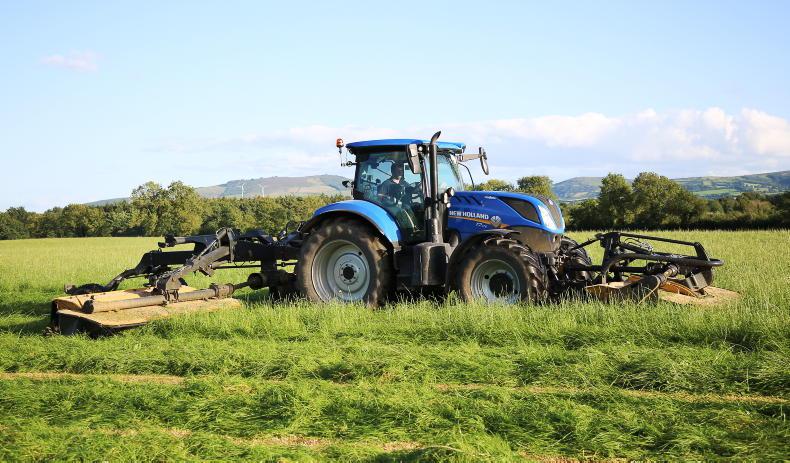
John initially designed the trailed rear butterfly mower combination to increase output and decrease the tractor requirements. \ Odhran Ducie
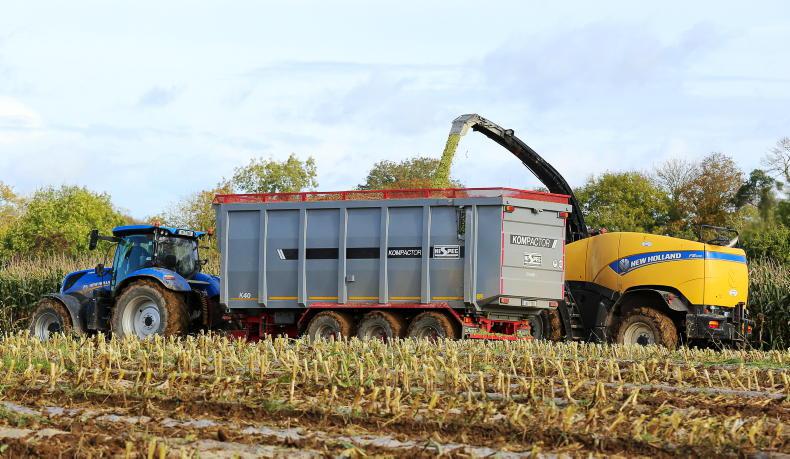
John now runs four Kompactor trailers, including the first ever model he built in his own workshop. \ Odhran Ducie
Getting started
Although having grown up on his family’s tillage farm, John set out from humble beginnings in 1991, with a Ford 4000 that he bought for £2,500 and a John Deere 1327 trailed mower. Having cut 1,000 acres annually for the next three summers, the Ford 4000 was upgraded to a 2wd 7610 and then a 7810. Before long, workload was increasing. John was now mowing, baling and drawing silage for locals. In 1998 he invested in an umbilical slurry spreading system.
“It was the first system in the area and being honest, this put me on the map,” says John. At that stage, he spent the winter months manufacturing bale handlers, gates, Christmas tree netters and other bits of equipment, as well as implements such as trailers and silage forks, for his growing contracting fleet.
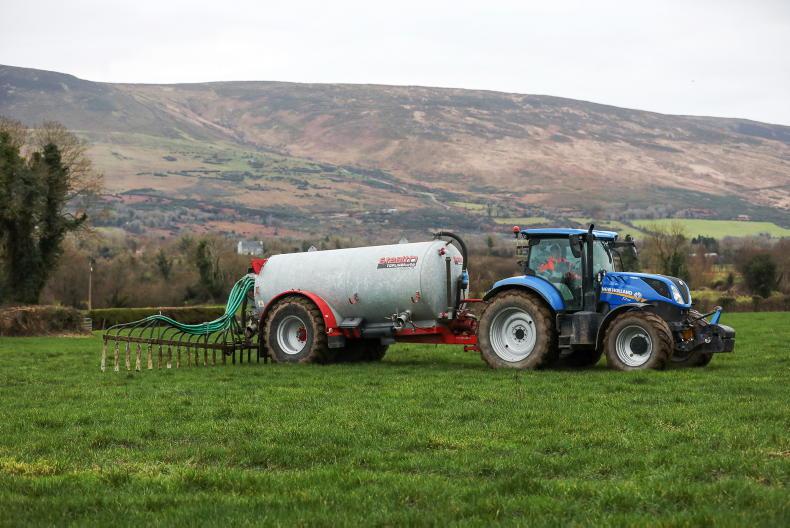
John runs a slurry tanker built by himself and features a hydraulic drawbar which allows the tanker to run offset to the tractor. \ Odhran Ducie
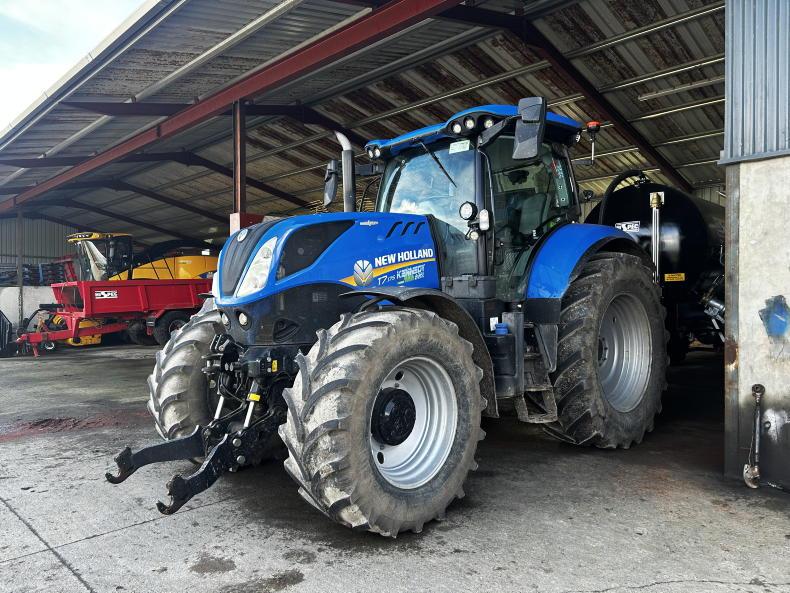
One of John's immaculate New Holland T7.175s, with almost 8,000 hours on the clock.
Pit silage
Not one to rest on his laurels, by 2001 John had bought his first new tractor, a New Holland TM 135, made the leap to a JF1100 trailed forage harvester and began cutting silage. The harvester was later upgraded to a JF1350 and then to a self-propelled machine in 2008.
“Cutting 1,200 acres in our last season with the 1350, we were under pressure to say the least. We needed to cut 80 acres/day on average to get through the work, it was becoming unsustainable. Leaving the yard at 4am wasn’t uncommon.”
The arrival of a brand new New Holland FR9040 hugely improved output in 2008. At that point, John was running two TSA 135As and 20ft Kane trailers. A New Holland LM410 telehandler was on the pit before the arrival of a JCB 416S.
“The FR9040 was a great machine, definitely ahead of its time. It was the smallest model in the range, I couldn’t justify the cost of anything larger. We didn’t know ourselves the first season out with it, we were doing less hours and more acres.”
Roll the clock forward to 2024, John now runs an FR550 having upgraded the F9040 in 2021, after 13 seasons.
“Again, the figures weren’t stacking up to go anything bigger. It’s proved itself as another super machine with no faults yet, thankfully. Next time around, I’ll strongly consider an FR650 I think.”
John wasn’t shy to outline that low running costs are one of his main attractions to the FR.
“The current 550 has three seasons done, cutting in the region of 2,500 acres annually. It’s on its second set of blades and shear bar. All the liners are 100% thanks to the Hardox package. So aside from a few pickup tines and engine services, its costing me a fraction of what it is to maintain competitor machines. Less than €2,000 has it ready for the coming season. The FR is the dark horse of the foragers,” John explained. Keeping up with things, elsewhere, he operates one set of Tanco butterfly mowers, two Krone rakes and four HiSpec Kompactor trailers, alongside a New Holland W170D loader.
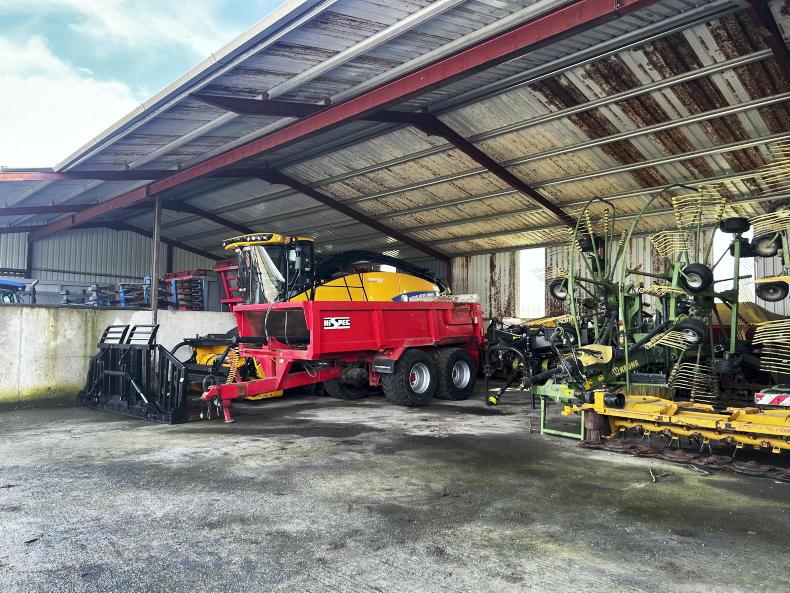
All machinery is meticulously maintained by John and the team.
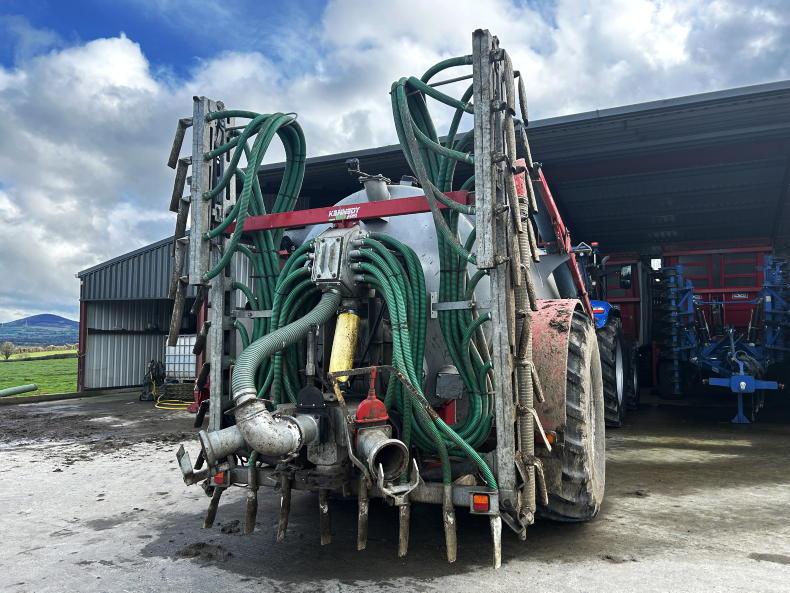
One of John's own 10m dribble bars.
Blue blood
Fondness for the Ford and New Holland brands was evident upon arriving at the yard.
“I was always of the belief, that if something treats you well then why change it? Over the years we’ve run 4000 series, 10 series, 40 and 60 series Fords, then New Holland TSs TMs, TSAs and now T7s. Touch wood they were all great machines for their time.
“When you show loyalty to a brand, you build trust and relationships with the people behind them, which couldn’t be more important when the day comes that you are broke down and need backup.
“Right now, we run two T7.175s, a T7.200 and a T7.270. In addition, I always hire a tractor for the summer season and then sub in two other drivers with tractors. I went down the route of the Autocommand CVT transmission in 2018 when buying the 175s and honestly, I’d never go back to a powershift – they’re economical on fuel and shorten the day for the operator. All four current tractors are Autocommand.”
Ease of operation and fuel economy are two main reasons for sticking with the transmission, John outlined.Otherwise, the tractors are all top spec models, with front-linkage and pto, exhaust brakes, LED lights, leather interiors, etc.
John has no qualms about buying second-hand, but considers himself choosey when doing so. He tends to focus on a machine’s history and condition rather than hours.
“Now nearing 8,000 hours, the two T7.175s have probably been the best tractors I have owned to date – size, power, reliability and fuel economy, they tick all the boxes. Aside from routine maintenance, one tractor got a new battery, other than that they haven’t been touched. They’ve both probably stayed a little longer than initially planned. I was waiting for the new cab to come down to the short wheelbase T7s. Now that it’s here, I’ve a deal done to trade the T7.175s for two new T7.230 PLMI tractors. The cab was a long time coming, but in fairness, it’s a major step forward,” John outlined.
Walking around the yard, it’s obvious that John meticulously maintains his machinery, given their condition and service in return. Accepting that no machine is perfect, he has made small modifications and added his own cosmetic touches to some areas. The best modification in his eyes has been the fitment of additional accumulators to the front suspension on the T7s to further improve the ride quality – a change that he feels turns the tractors inside out. Cosmetically, the wheel rims have been sprayed either silver or black over the years, although now edging more towards the latter.
In addition to the New Holland foragers mentioned already, John now runs a W170D loading shovel, which he bought second-hand in 2023.
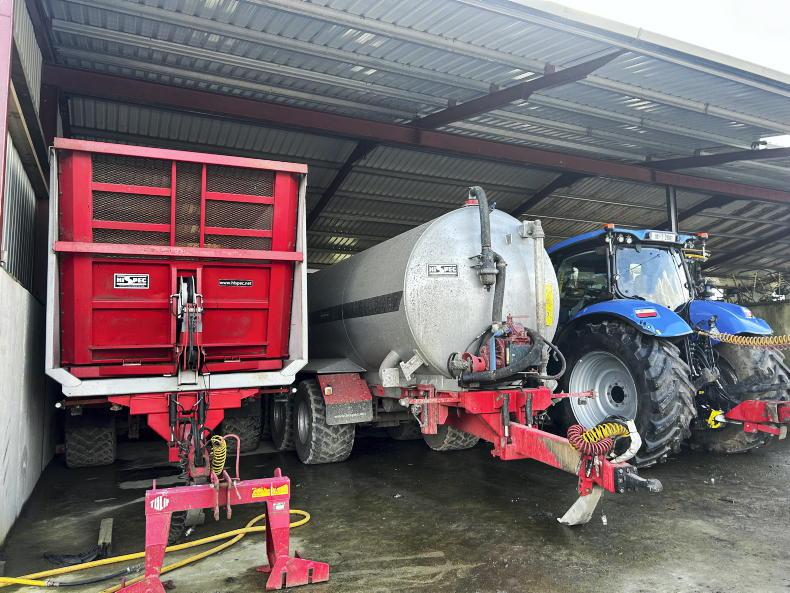
John runs a demountable HiSpec Kompactor, which means the K40 body can be removed from the chassis and swapped with a 5,000 gallon tanker body in 10 minutes.
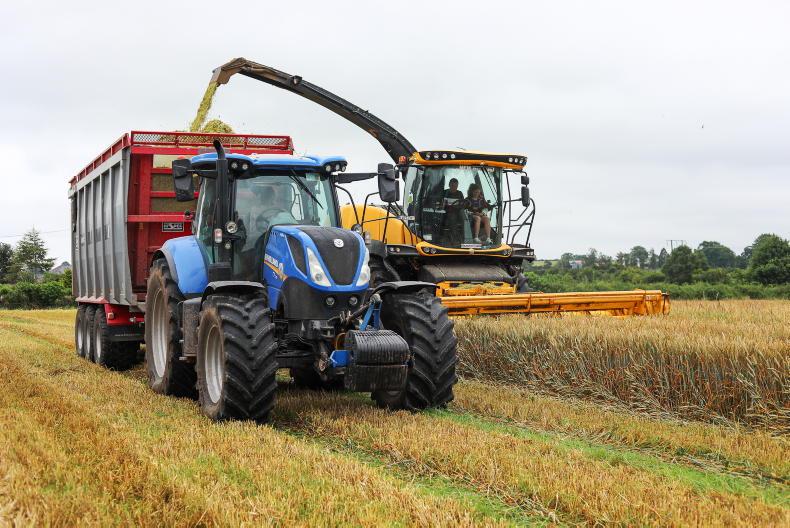
Last season, 2,500 acres of grass silage, maize and wholecrop were cut. \ Odhran Ducie
Machine design
John has always had an interest in finding a better solution to a problem or discovering ways to further utilise a machine, a trait he picked up from his father. One such example was when his father fitted a starter motor to the manual tying system on a Krone baler to speed up the twine tying process.
In 2012, John found that a lack of trailers was limiting output. He also felt that space within a standard tipping trailer was being underutilised. It was then he came up with the idea of building his own take on an ejector-style trailer, which could compact the silage as it was being loaded so that more silage could be carried by a trailer of the same dimensions.
That winter he got to work with nothing more than a vision. The result was the earliest form of what we now know as the HiSpec Kompactor 36. After a period of testing and tweaks, John was happy with the result.
At Grass & Muck 2014, under his own brand Stealth Manufacturing, John presented the trailer alongside a slurry tanker he had designed to run offset with the tractor. He was crowned winner of the JFC Innovation award for his trailer concept at the event that year.
But, as time went on, becoming busier with the contracting business and not in a position to scale up the manufacturing business, John decided to partner with HiSpec, that would take on the production of the Kompactor trailers.
Today, HiSpec offers three Kompactor models, namely the K36 (22ft), K40 (24ft) and K50 (28ft), with each model number referring to the specific cubic capacities.
After a tough season in 2014, John’s next focus was to increase his mowing capacity to 20ac/hr and move away from running two tractors with two trailed and one front mower, to just one average size tractor and one butterfly combination. In essence, he wanted something that would work comfortably with 170hp, the largest tractor within his fleet at the time.
“I bought a scrap Kuhn butterfly outfit of WW Doherty & Sons Ltd in Adare, removed the conditioners and built the beds onto a chassis and rear axle. The result was a non-conditioner butterfly combination that could support its own weight and work comfortably with 175hp. After tweaking the suspension it worked well. It didn’t matter that the out rows were not conditioned as they were being raked in on the front conditioned row. For a period, HiSpec took on the project called Autocut, which i have supported since Grass and Muck 2016. Tanco later took over the project and further developed it to where it is today,” says John.
More recently, John has manufactured his own 10m dribble bars and high-output slurry agitator. He also manufactures three-point linkage weight carriers and polycarbonate covers for the back-end of tractors to prevent dirt and debris build up. That said, he has plans to get back into the workshop and modify and develop two machines to further speed up two services he provides.
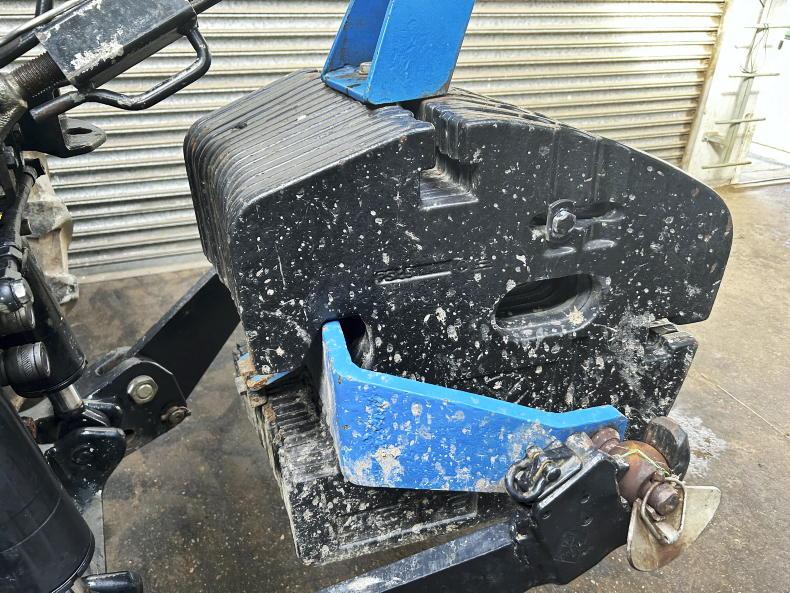
John manufactured a three-point linkage kit for New Holland, fan style front weights.
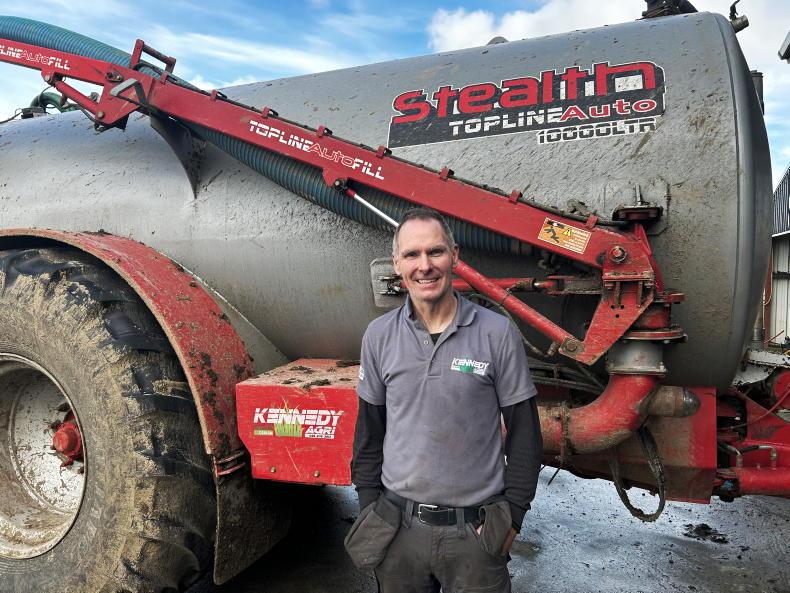
John Kennedy, Nenagh, Co Tipperary.
Future
We asked John about the plans for the contracting business and his views on the future of the sector.
“My plans are to continue what I’m doing and work to improve aspects of the business, while keeping a close eye on machinery running costs. I love contracting, operating machinery and working the land, but it’s a business at the end of the day and it needs to be treated like that. I got out of tillage work eight years ago. There simply was no money in it for the machinery involved.”
That said, John is always on the lookout for an opportunity. One of the more recent ventures was the purchase of a section-control Amazone fertiliser spreader, which allows him to offer a spreading service. One season on, he feels it fits the business well, especially in spring when things are typically quieter.
On the topic of current fuel prices, machinery prices and a shortage of skilled operators, John said: “We need to look straightaway to what we can adjust that is within our control. That could be going from a 3m to a 6m power harrow, doubling output for one man and one tractor – things like that to improve the efficiency of the job.”
The move to the Kompactor trailers and Autocut mowers are two prime examples of how John streamlined his business going back years. It’s quoted that the Kompactor claims a 30% greater grass carrying capacity in comparison to a trailer of the same dimensions.
“I may be biased, but they’re something all contractors should be considering, not only from the point of view of additional capacity, but also safety, as there is no tipping body.”
John feels that a smart approach to machinery investment is critical.
“It’s not about buying the largest tractor within a range for the sake of it – it needs to be justified. Nowadays, the only difference between certain models is the software, while the physical specification may be identical. With tractors and certain machinery, if there are savings to be made, I’d be one to look at the specs and go for the lower horsepower option if everything else matches aside from engine output. Engine power can be easily sorted. Opting for T7.175s instead of T7.210s was a good example of this. As contractors, we are our own worst enemy and that needs to change, there is too much under cutting going on. We need to be more professional in how we do business.
“Taking the time to teach younger, inexperienced operators, properly planning work, making informed buying decisions, invoicing on time, etc. With all the traits now needed to be a contractor, I often think there should be a college course for those wanting to get involved in the sector,” John explained.
Safety is another issue that needs to be taken more seriously, John believes. All his tractors are fitted with front- and rear-facing dash cameras as well as cameras fitted to all trailed and large mounted implements. He believes that the adoption of technology is important for the future of any contracting business. Whether that’s in the form of GPS autosteer, yield mapping, nutrient sensing and subsequently variable rate applications, etc. He feels that whether we like it or not, it is the future.
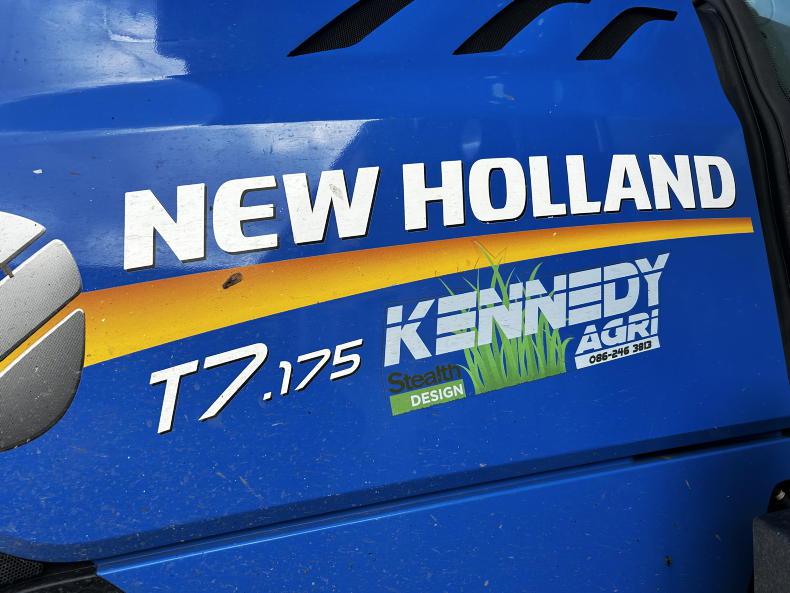
John Kennedy Agri.
Located on the outskirts of Nenagh, Co Tipperary, John Kennedy runs an agricultural contracting business with the help of his son, John Jnr. The team serves a long-standing client base within a 20km radius, with forage harvesting, slurry spreading, reseeding, hedge-cutting and fertiliser-spreading being the main services offered.
Aside from running a shrewd business, John is a talented machinery designer and fabricator; best known within Irish agricultural engineering and contracting circles as the man who designed and built the first HiSpec Kompactor ejector-style trailer and Tanco’s Autocut trailed butterfly mower combination. Believe it or not, both impressive pieces of machinery were originally built in the workshop in which we stood, out of necessity to improve the output of his contracting business at the time.
What is particularly impressive about the setup is the professional manner in which the business is managed. Efficiency is the word that best summarises the enterprise, and arguably is a large contributor to its success throughout the past 33 years.
“Scale doesn’t so much interest me. I operate what I can manage comfortably and profitably. It’s not always about who’s doing the most work or running the shiniest machinery. It’s all relative. The more machinery you have, the more work and drivers are needed and so on. Being a busy fool is a real thing. The margins are too tight not to know your costings, what’s profitable and what’s not,” says John.

John initially designed the trailed rear butterfly mower combination to increase output and decrease the tractor requirements. \ Odhran Ducie

John now runs four Kompactor trailers, including the first ever model he built in his own workshop. \ Odhran Ducie
Getting started
Although having grown up on his family’s tillage farm, John set out from humble beginnings in 1991, with a Ford 4000 that he bought for £2,500 and a John Deere 1327 trailed mower. Having cut 1,000 acres annually for the next three summers, the Ford 4000 was upgraded to a 2wd 7610 and then a 7810. Before long, workload was increasing. John was now mowing, baling and drawing silage for locals. In 1998 he invested in an umbilical slurry spreading system.
“It was the first system in the area and being honest, this put me on the map,” says John. At that stage, he spent the winter months manufacturing bale handlers, gates, Christmas tree netters and other bits of equipment, as well as implements such as trailers and silage forks, for his growing contracting fleet.

John runs a slurry tanker built by himself and features a hydraulic drawbar which allows the tanker to run offset to the tractor. \ Odhran Ducie

One of John's immaculate New Holland T7.175s, with almost 8,000 hours on the clock.
Pit silage
Not one to rest on his laurels, by 2001 John had bought his first new tractor, a New Holland TM 135, made the leap to a JF1100 trailed forage harvester and began cutting silage. The harvester was later upgraded to a JF1350 and then to a self-propelled machine in 2008.
“Cutting 1,200 acres in our last season with the 1350, we were under pressure to say the least. We needed to cut 80 acres/day on average to get through the work, it was becoming unsustainable. Leaving the yard at 4am wasn’t uncommon.”
The arrival of a brand new New Holland FR9040 hugely improved output in 2008. At that point, John was running two TSA 135As and 20ft Kane trailers. A New Holland LM410 telehandler was on the pit before the arrival of a JCB 416S.
“The FR9040 was a great machine, definitely ahead of its time. It was the smallest model in the range, I couldn’t justify the cost of anything larger. We didn’t know ourselves the first season out with it, we were doing less hours and more acres.”
Roll the clock forward to 2024, John now runs an FR550 having upgraded the F9040 in 2021, after 13 seasons.
“Again, the figures weren’t stacking up to go anything bigger. It’s proved itself as another super machine with no faults yet, thankfully. Next time around, I’ll strongly consider an FR650 I think.”
John wasn’t shy to outline that low running costs are one of his main attractions to the FR.
“The current 550 has three seasons done, cutting in the region of 2,500 acres annually. It’s on its second set of blades and shear bar. All the liners are 100% thanks to the Hardox package. So aside from a few pickup tines and engine services, its costing me a fraction of what it is to maintain competitor machines. Less than €2,000 has it ready for the coming season. The FR is the dark horse of the foragers,” John explained. Keeping up with things, elsewhere, he operates one set of Tanco butterfly mowers, two Krone rakes and four HiSpec Kompactor trailers, alongside a New Holland W170D loader.

All machinery is meticulously maintained by John and the team.

One of John's own 10m dribble bars.
Blue blood
Fondness for the Ford and New Holland brands was evident upon arriving at the yard.
“I was always of the belief, that if something treats you well then why change it? Over the years we’ve run 4000 series, 10 series, 40 and 60 series Fords, then New Holland TSs TMs, TSAs and now T7s. Touch wood they were all great machines for their time.
“When you show loyalty to a brand, you build trust and relationships with the people behind them, which couldn’t be more important when the day comes that you are broke down and need backup.
“Right now, we run two T7.175s, a T7.200 and a T7.270. In addition, I always hire a tractor for the summer season and then sub in two other drivers with tractors. I went down the route of the Autocommand CVT transmission in 2018 when buying the 175s and honestly, I’d never go back to a powershift – they’re economical on fuel and shorten the day for the operator. All four current tractors are Autocommand.”
Ease of operation and fuel economy are two main reasons for sticking with the transmission, John outlined.Otherwise, the tractors are all top spec models, with front-linkage and pto, exhaust brakes, LED lights, leather interiors, etc.
John has no qualms about buying second-hand, but considers himself choosey when doing so. He tends to focus on a machine’s history and condition rather than hours.
“Now nearing 8,000 hours, the two T7.175s have probably been the best tractors I have owned to date – size, power, reliability and fuel economy, they tick all the boxes. Aside from routine maintenance, one tractor got a new battery, other than that they haven’t been touched. They’ve both probably stayed a little longer than initially planned. I was waiting for the new cab to come down to the short wheelbase T7s. Now that it’s here, I’ve a deal done to trade the T7.175s for two new T7.230 PLMI tractors. The cab was a long time coming, but in fairness, it’s a major step forward,” John outlined.
Walking around the yard, it’s obvious that John meticulously maintains his machinery, given their condition and service in return. Accepting that no machine is perfect, he has made small modifications and added his own cosmetic touches to some areas. The best modification in his eyes has been the fitment of additional accumulators to the front suspension on the T7s to further improve the ride quality – a change that he feels turns the tractors inside out. Cosmetically, the wheel rims have been sprayed either silver or black over the years, although now edging more towards the latter.
In addition to the New Holland foragers mentioned already, John now runs a W170D loading shovel, which he bought second-hand in 2023.

John runs a demountable HiSpec Kompactor, which means the K40 body can be removed from the chassis and swapped with a 5,000 gallon tanker body in 10 minutes.

Last season, 2,500 acres of grass silage, maize and wholecrop were cut. \ Odhran Ducie
Machine design
John has always had an interest in finding a better solution to a problem or discovering ways to further utilise a machine, a trait he picked up from his father. One such example was when his father fitted a starter motor to the manual tying system on a Krone baler to speed up the twine tying process.
In 2012, John found that a lack of trailers was limiting output. He also felt that space within a standard tipping trailer was being underutilised. It was then he came up with the idea of building his own take on an ejector-style trailer, which could compact the silage as it was being loaded so that more silage could be carried by a trailer of the same dimensions.
That winter he got to work with nothing more than a vision. The result was the earliest form of what we now know as the HiSpec Kompactor 36. After a period of testing and tweaks, John was happy with the result.
At Grass & Muck 2014, under his own brand Stealth Manufacturing, John presented the trailer alongside a slurry tanker he had designed to run offset with the tractor. He was crowned winner of the JFC Innovation award for his trailer concept at the event that year.
But, as time went on, becoming busier with the contracting business and not in a position to scale up the manufacturing business, John decided to partner with HiSpec, that would take on the production of the Kompactor trailers.
Today, HiSpec offers three Kompactor models, namely the K36 (22ft), K40 (24ft) and K50 (28ft), with each model number referring to the specific cubic capacities.
After a tough season in 2014, John’s next focus was to increase his mowing capacity to 20ac/hr and move away from running two tractors with two trailed and one front mower, to just one average size tractor and one butterfly combination. In essence, he wanted something that would work comfortably with 170hp, the largest tractor within his fleet at the time.
“I bought a scrap Kuhn butterfly outfit of WW Doherty & Sons Ltd in Adare, removed the conditioners and built the beds onto a chassis and rear axle. The result was a non-conditioner butterfly combination that could support its own weight and work comfortably with 175hp. After tweaking the suspension it worked well. It didn’t matter that the out rows were not conditioned as they were being raked in on the front conditioned row. For a period, HiSpec took on the project called Autocut, which i have supported since Grass and Muck 2016. Tanco later took over the project and further developed it to where it is today,” says John.
More recently, John has manufactured his own 10m dribble bars and high-output slurry agitator. He also manufactures three-point linkage weight carriers and polycarbonate covers for the back-end of tractors to prevent dirt and debris build up. That said, he has plans to get back into the workshop and modify and develop two machines to further speed up two services he provides.

John manufactured a three-point linkage kit for New Holland, fan style front weights.

John Kennedy, Nenagh, Co Tipperary.
Future
We asked John about the plans for the contracting business and his views on the future of the sector.
“My plans are to continue what I’m doing and work to improve aspects of the business, while keeping a close eye on machinery running costs. I love contracting, operating machinery and working the land, but it’s a business at the end of the day and it needs to be treated like that. I got out of tillage work eight years ago. There simply was no money in it for the machinery involved.”
That said, John is always on the lookout for an opportunity. One of the more recent ventures was the purchase of a section-control Amazone fertiliser spreader, which allows him to offer a spreading service. One season on, he feels it fits the business well, especially in spring when things are typically quieter.
On the topic of current fuel prices, machinery prices and a shortage of skilled operators, John said: “We need to look straightaway to what we can adjust that is within our control. That could be going from a 3m to a 6m power harrow, doubling output for one man and one tractor – things like that to improve the efficiency of the job.”
The move to the Kompactor trailers and Autocut mowers are two prime examples of how John streamlined his business going back years. It’s quoted that the Kompactor claims a 30% greater grass carrying capacity in comparison to a trailer of the same dimensions.
“I may be biased, but they’re something all contractors should be considering, not only from the point of view of additional capacity, but also safety, as there is no tipping body.”
John feels that a smart approach to machinery investment is critical.
“It’s not about buying the largest tractor within a range for the sake of it – it needs to be justified. Nowadays, the only difference between certain models is the software, while the physical specification may be identical. With tractors and certain machinery, if there are savings to be made, I’d be one to look at the specs and go for the lower horsepower option if everything else matches aside from engine output. Engine power can be easily sorted. Opting for T7.175s instead of T7.210s was a good example of this. As contractors, we are our own worst enemy and that needs to change, there is too much under cutting going on. We need to be more professional in how we do business.
“Taking the time to teach younger, inexperienced operators, properly planning work, making informed buying decisions, invoicing on time, etc. With all the traits now needed to be a contractor, I often think there should be a college course for those wanting to get involved in the sector,” John explained.
Safety is another issue that needs to be taken more seriously, John believes. All his tractors are fitted with front- and rear-facing dash cameras as well as cameras fitted to all trailed and large mounted implements. He believes that the adoption of technology is important for the future of any contracting business. Whether that’s in the form of GPS autosteer, yield mapping, nutrient sensing and subsequently variable rate applications, etc. He feels that whether we like it or not, it is the future.

John Kennedy Agri.

















 This is a subscriber-only article
This is a subscriber-only article










SHARING OPTIONS: